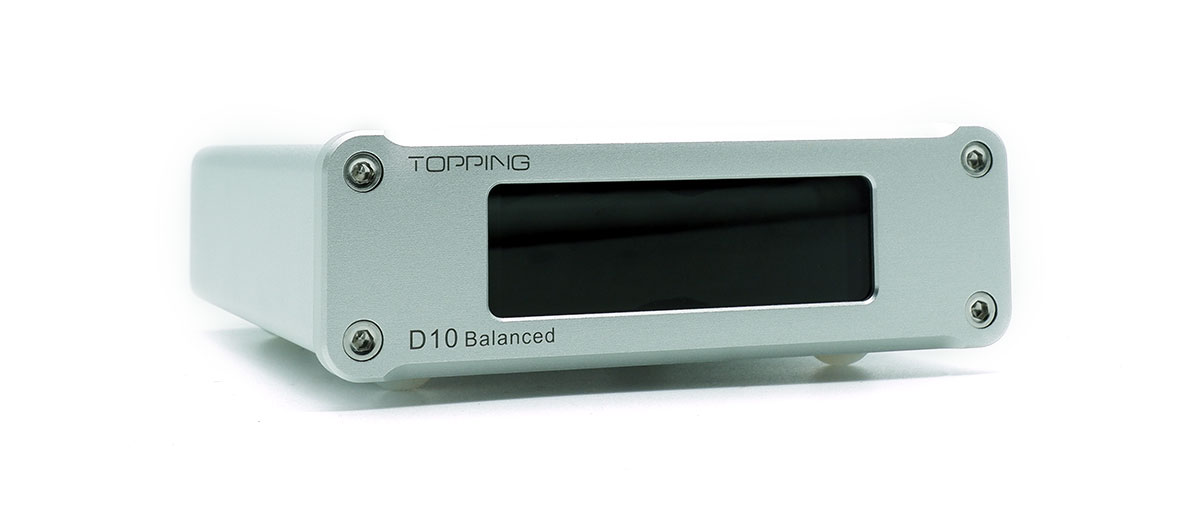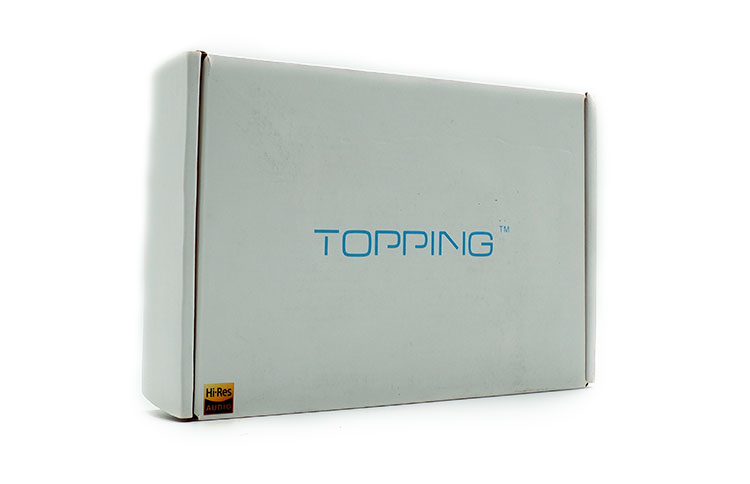Select Comparisons
Topping D10S
$99
Technical
With their model numbers only differing by just 1 letter, it makes a lot of sense that the internals of both these DACs are also pretty similar.
Both DACs have an XMOS XU208 USB controller, while they also have the same ES9038 Q2M DAC chip. This results in these two delivering the same decoding capabilities topping out at 32BIT/384kHz PCM and DSD256.
However, being limited to just single-ended, the D10s has a SINAD that’s a notch lower at 113dB, and a measured dynamic range of just 120dB. One thing of note though is that Topping advertises that the D10s has the option for opamp rolling.
Design
Looking at them from a distance, the front fascia of both DACs look the same, except for the model name. The D10s is more marked having both a DSD logo and the sample rates written in front.
The rear is also a similar affair, with most of the ports located at the same spot on both devices, except that the D10s only has standard single-ended RCA connectors instead of balanced ¼” connectors.
The biggest difference in looks though is that the D10s has a side seam that allows for the user to easily pop open the top cover of the DAC. This allows for easy access for op-amp rolling, which I believe is a feature that was removed with the D10 Balanced.
Performance
Having similar USB controllers and DAC chips, and being manufactured by the same company, it’s to be expected that these 2 devices have a similar presentation. They both exhibit that Topping house sound, having an overall weighty bass region, and generally enjoyable and safe presentation.
Based on the specs, the D10s is a step behind in terms of SINAD and dynamic range, and this translates to differences in how the nuances of the music are presented. With bass detail being a shade behind on the D10s, drum hits sound more dispersed while having less control over the decay structures in drum hits.
Midrange timbre is still similar, but the leading edges of notes are less prominent on the D10s. This also leads to the D10s being a shade behind when it comes to overall vocal and instrumental texture, making vocals more glossed over comparatively.
Although both DACs have a generally smooth treble presentation, the D10s is even smoother, making cymbal hits even less edgy, but the decay in each cymbal hit is equally splashy.
The D10s treble sounds less authoritative compared to the D10 Balanced performance. There is a notable roll-off in the treble making the D10s sound more compressed.
Both DACs are not the widest, but being a step behind in terms of dynamic range, the layering within the soundstage on D10s is more compressed. Although they both create images generally accurately, the details particularly the way the images are chiseled are still equal.
Overall, soundstage can be wide on both DACs, it’s just that layering suffers overall on more revealing downstream equipment.
Khadas Tone2 Pro
$199
Technical
While the Tone2 Pro is a more expensive DAC, it also features a headphone amplifier section that has both a balanced and single-ended output option. Both devices can be classified as compact DACs, and they are both powered using USB input, while they both offer balanced outputs in a compact package.
My comparisons will only be comparing the balanced output section of the Tone2 Pro which interestingly also features an ES9038 Q2M DAC. However, the USB controller on the Tone2 Pro is an XMOS XU216 which enables MQA decoding.
Furthermore, the Tone2 Pro is capable of decoding 32bit/384kHz PCM streams and DSD512. However, the higher resolution streaming capabilities shouldn’t make much of a difference since they are both still perfectly capable of decoding most currently available files.
In terms of measurements, the Tone2 Pro falls a step behind having a SINAD of just 118dB, and a dynamic range of just 121dB. It remains to be seen though if these numbers would translate to real-world differences between the 2 DACs.
Design
Both DACs are designed to be a compact desktop DAC, but the Tone2 Pro is still smaller despite having a headphone amplifier section. However, the Tone2 Pro uses more compact input and output ports, with a USB C port instead of the more traditional USB B port.
Then the balanced connections are achieved using a proprietary RCA terminal that requires special RCA cables which can end up being harder to source compared to the relatively more common ¼” TRS balanced connection.
Because of the smaller form factor, the Tone2 Pro doesn’t have a display, instead, the ring around the volume dial is used to display the sample rate of the file currently being decoded. For me, this is of course more difficult than seeing the sample rate directly as numbers in a display.
While both DACs have a mostly aluminum chassis, the Tone2 Pro has a much more modern design, with sharper edges, and accents. Also, the Tone2 Pro comes in edgier colors, such as red and blue, and the more common black finish.
Performance
Being USB powered, I was expecting similar limitations for both devices being that the slew rate of crescendos should be limited by the power supply availability. And true enough, both DACs performed about equally in this front.
When it comes to tonal balance, both DACs strive for neutrality, but the Tone2 Pro is seemingly more dynamic due to the mid-bass hump without the added weight due to the rest of the bass. This results in the Tone2 Pro sounding more rounded, and seemingly more impactful, despite having the same level of definition and texture in the bass region.
The vocal quality on the other hand has a richer and more euphonic delivery with the Tone2 Pro, which may be more enjoyable for some while not being entirely honest. This also translates to a more weighty and liquid presentation of acoustic instruments, while having an even-handed tonal balance.
Treble frequencies, particularly cymbals are more prominent on the Tone2 Pro, so it has more potential to become sibilant with lesser recordings. However, the added edginess of the treble frequencies on the Tone2 Pro can make things more engaging as long as the music doesn’t overdo it.
While both DACs create a generally wide soundstage presentation, the placement of the images within the soundstage is equally accurate. Both DACs can easily create relatively intimate images, but the Tone2 Pro simply becomes more dispersed when the track, headphone amplifier, and headphones allow for it.
Our Verdict
Topping has been pushing the boundaries of what can be possible at different price points, and the D10 Balanced is very competitive for the price point.
Topping has offered a fully capable balanced DAC in a chassis that’s mostly similar to what they have with their D10s entry-level DAC. It even features a coaxial and optical digital output, which makes the D10 Balanced a more versatile device, as it can simply be used as a USB to coaxial converter.
While the D10 Balanced looks much like an entry-level DAC, it’s a clear step up from most entry-level offerings. The D10 Balanced offers a safer tonal balance that ensures most tracks won’t become sibilant even with more energetic downstream equipment.
This ensures that the D10 Balanced can be used as a DAC for lots of amplifiers, and headphones alike without making them sound too fatiguing.
Topping D10 Balanced Specifications
- High-Performance ES9038Q2M ESS Sabre DAC Chip
- XMOS XU208 USB Processor
- Decoding: PCM up to 32-Bit/384kHz.
- Native DSD256 Decoding.
- THD+N: 0.00012%.
- Balanced TRS Line-Out
- Digital Coaxial & Optical Output
- Customised Windows ASIO Drivers
- Line-Out: 6.35mm TRS(No Single-Ended Output)
- THD+N@1kHz A-weighted: <0.00012%
- THD: <0.00015% @ 20Hz-20kHz
- SNR: 125dB
- Dynamic Range: 125dB.
- Frequency Response: 20Hz-20kHz
- Channel Crosstalk: -141dB
- Channel Balance: 0.3dB
- Output Impedance: 88 ohm




